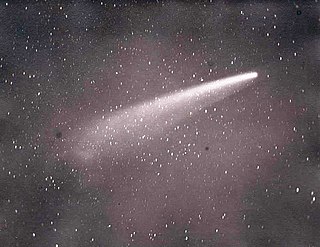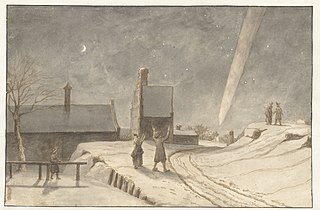
Amateur astronomy is a hobby where participants enjoy observing or imaging celestial objects in the sky using the unaided eye, binoculars, or telescopes. Even though scientific research may not be their primary goal, some amateur astronomers make contributions in doing citizen science, such as by monitoring variable stars, double stars, sunspots, or occultations of stars by the Moon or asteroids, or by discovering transient astronomical events, such as comets, galactic novae or supernovae in other galaxies.

Astrophotography, also known as astronomical imaging, is the photography or imaging of astronomical objects, celestial events, or areas of the night sky. The first photograph of an astronomical object was taken in 1840, but it was not until the late 19th century that advances in technology allowed for detailed stellar photography. Besides being able to record the details of extended objects such as the Moon, Sun, and planets, modern astrophotography has the ability to image objects outside of the visible spectrum of the human eye such as dim stars, nebulae, and galaxies. This is accomplished through long time exposure as both film and digital cameras can accumulate and sum photons over long periods of time or using specialized optical filters which limit the photons to a certain wavelength.
Robert H. McNaught is a Scottish-Australian astronomer at the Research School of Astronomy and Astrophysics of the Australian National University (ANU). He has collaborated with David J. Asher of the Armagh Observatory.

A sungrazing comet is a comet that passes extremely close to the Sun at perihelion – sometimes within a few thousand kilometres of the Sun's surface. Although small sungrazers can completely evaporate during such a close approach to the Sun, larger sungrazers can survive many perihelion passages. However, the strong evaporation and tidal forces they experience often lead to their fragmentation.

The Great Comet of 1882 formally designated C/1882 R1, 1882 II, and 1882b, was a comet which became very bright in September 1882. It was a member of the Kreutz Sungrazers, a family of comets which pass within 1 R☉ of the Sun's photosphere at perihelion. The comet was bright enough to be visible next to the Sun in the daytime sky at its perihelion. The comet made its closest approach to Earth on 16 September 1882 at 0.99 AU and then came to perihelion the next day on 17 September.
The Kreutz sungrazers are a family of sungrazing comets, characterized by orbits taking them extremely close to the Sun at perihelion. At the far extreme of their orbits, aphelion, Kreutz sungrazers can be a hundred times farther from the Sun than the Earth is, while their distance of closest approach can be less than twice the Sun's radius. They are believed to be fragments of one large comet that broke up several centuries ago and are named for German astronomer Heinrich Kreutz, who first demonstrated that they were related. These sungrazers make their way from the distant outer Solar System to the inner Solar System, to their perihelion point near the Sun, and then leave the inner Solar System in their return trip to their aphelion.

Heinrich Carl Friedrich Kreutz was a German astronomer, most notable for his studies of the orbits of several sungrazing comets, which revealed that they were all related objects, produced when a very large Sun-grazing comet fragmented several hundred years previously. The group is now known as the Kreutz Sungrazers, and has produced some of the brightest comets ever seen, including X/1106 C1 and Comet Ikeya–Seki. The source of the group may have been the Great Comet of 371 BC.

Comet White–Ortiz–Bolelli was a bright comet which appeared in 1970. It was a member of the Kreutz Sungrazers, a family of comets which resulted from the break-up of a large parent comet several centuries ago. It was already easily visible to the naked eye when first discovered, and reached a maximum apparent magnitude of +1.

C/1680 V1, also called the Great Comet of 1680, Kirch's Comet, and Newton's Comet, was the first comet discovered by telescope. It was discovered by Gottfried Kirch and was one of the brightest comets of the seventeenth century.
Lovejoy is a British television series starring Ian McShane.
Comet Lovejoy may refer to any comets below discovered by Terry Lovejoy:
John "Jack" Borden Newton is a Canadian astronomer, best known for his publications and images in amateur astrophotography.
Comet 322P/SOHO, also designated P/1999 R1, P/2003 R5, P/2007 R5, and P/2011 R4, is the first periodic comet to be discovered using the automated telescopes of the SOHO spacecraft, and second to be given a numbered designation, after 321P/SOHO. JPL Horizons next predicts 322P to come to perihelion on 21 August 2023 at around apparent magnitude 6 and only 3 degrees from the Sun. At perihelion it is six times closer to the Sun than the planet Mercury is at perihelion.

P78-1 or Solwind was a United States satellite launched aboard an Atlas F rocket from Vandenberg Air Force Base in California on February 24, 1979. The satellite's mission was extended by several weeks, so that it operated until it was destroyed in orbit on September 13, 1985, to test the ASM-135 ASAT anti-satellite missile.

The Great Southern Comet of 1887, or C/1887 B1 using its International Astronomical Union (IAU) designation, was a bright comet seen from the Southern Hemisphere during January 1887. Later calculations indicated it to be part of the Kreutz Sungrazing group. It came to perihelion on 11 January 1877 at a distance of 0.00483 AU (723 thousand km) with a velocity of 606.1 km/s. Since the Sun has a radius of 696000 km, the comet passed about 27000 km from the surface of the Sun.

Comet Lovejoy, formally designated C/2011 W3 (Lovejoy), is a long-period comet and Kreutz sungrazer. It was discovered in November 2011 by Australian amateur astronomer Terry Lovejoy. The comet's perihelion took it through the Sun's corona on 16 December 2011, after which it emerged intact, though greatly impacted by the event.
The Edgar Wilson Award is an annual international award established in 1998 consisting of a monetary award and a plaque allocated annually to amateur comet discoverers. It is administered by the Smithsonian Astrophysical Observatory (SAO) through the IAU's Central Bureau for Astronomical Telegrams (CBAT).
Comet C/2012 E2 (SWAN) was a Kreutz group sungrazing comet discovered by Vladimir Bezugly in publicly available images taken by the SWAN instrument on board the SOHO spacecraft. It is recognized for being the first Kreutz sungrazer observed in SWAN imagery.

C/2024 S1 (ATLAS) was a sungrazing comet that was discovered by ATLAS-HKO in Hawaii on 27 September 2024. The comet passed its perihelion on 28 October 2024, at a distance of about 0.008 AU from the barycenter of the Solar System, and disintegrated. The comet had a similar orbit to the Kreutz sungrazers, which were created by the fragmentation of a large comet.















